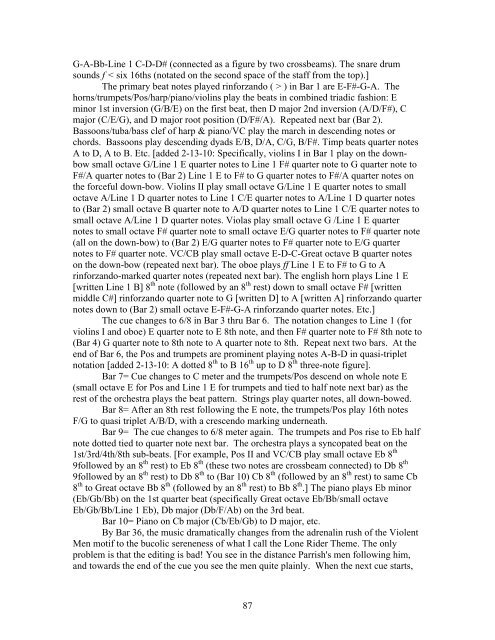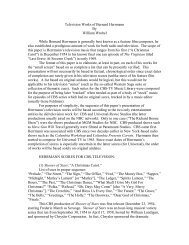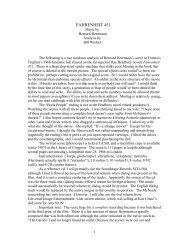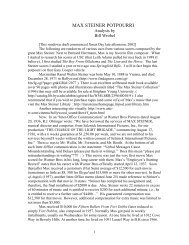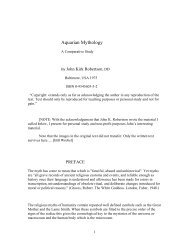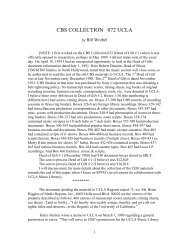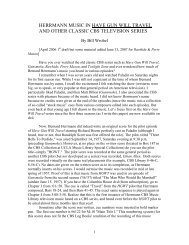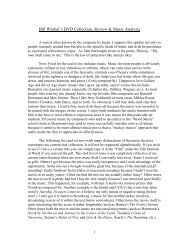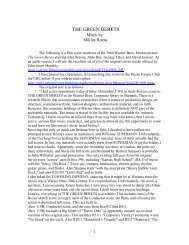Reel 11 pt 8 [?? Typo error no doubt--probably should be Reel 11 pt1] "Finale" Allegro maestoso in 3/2 meter. 5 bars, :13.Bass Cls/Fag I/PosI/Tuba play "pesante" half notes D/A/F to (bar 2) E whole note. Then Dhalf note to (bar 3) the B-fl<strong>at</strong>(major)chord 2nd inv (F/Bb/D). Then theHorns & Tpts play half notes Bb/F/D to (bar 4) note A. The Pos thenresound a D (major)1st inv chord (F#/A/D)along with the Studio Organand Bass Cls. etc.Bill Wrobel wj@pavenet.net**********************************The s<strong>am</strong>e applies to Steiner’s The Violent Men starring Glenn Ford. I havequite detailed inform<strong>at</strong>ion on this score so maybe some day I’ll expand on this oldrundown below written originally in 1999. I’ll add some new m<strong>at</strong>erial below usually ayadding today’s d<strong>at</strong>e [2-13-<strong>10</strong>] or simply sentences within brackets [ ].VIOLENT MENMusic byMax SteinerThe following is a cue rundown and analysis of Max Steiner's vibrant score to the1955 motion picture, The Violent Men (aka "Rough Company"). Only the second and lastscore Max composed for Columbia Pictures, THE VIOLENT MEN proved to be anappealing B western, thanks in large part to Glenn Ford's likeable performance as JohnParrish, to the stunning CinemaScope loc<strong>at</strong>ion shooting of Alab<strong>am</strong>a Hills(Lone Pine, Ca),and to the rousing stereo score of Max Steiner. Edward G. Robinson (one of my favoriteactors) plays Lew Wilkerson, an overly <strong>am</strong>bitious but crippled rancher, and BarbaraStanwyck plays his scheming, che<strong>at</strong>ing wife, Martha. Brian Keith plays his jealousforeman brother, Cole. Richard Jaeckel gives a dyn<strong>am</strong>ic performance as Wade M<strong>at</strong>lock,the evil enforcer-hired gun. The full score is orchestr<strong>at</strong>ed by Murray Cutter.THE VIOLENT MENReel 1/A "Main Title" Robusto in C time, 12pp., 56 bars. 1:37. Cue #9882.Orchestr<strong>at</strong>ion: flute/piccolo, oboe/English Horn, 2 clarinets, 2 Fags(bassoons), 4 frenchhorns, 3 trumpets in B-fl<strong>at</strong>, 3 Pos(trombones), tuba, timpani, snare drum, cymbals, bells,harp, piano, organ, 12 violins, 4 violas, 4 VC (celli), 3 CB(basses).As the Columbia Pictures logo lady shines her torch on the screen, the musicimmedi<strong>at</strong>ely provides a sweeping six-note figure of 16th notes (G-A-Bb-C-D-D#) of theE.H./clarinets/Fags/horns/strings, with the snare drum adding sharp percussion. Thissweep of the grace bar leads to the four quarter note be<strong>at</strong> of Bar 1 (and Bar 2).[added 2-13-<strong>10</strong>: Specifically, the violins/violas/English horn/clarinets/horns I-II(top staff) sound ff small octave (Gre<strong>at</strong> octave for bassoons/VC/CB) “6” sextuplet 16ths86
G-A-Bb-Line 1 C-D-D# (connected as a figure by two crossbe<strong>am</strong>s). The snare drumsounds f < six 16ths (not<strong>at</strong>ed on the second space of the staff from the top).]The primary be<strong>at</strong> notes played rinforzando ( > ) in Bar 1 are E-F#-G-A. Thehorns/trumpets/Pos/harp/piano/violins play the be<strong>at</strong>s in combined triadic fashion: Eminor 1st inversion (G/B/E) on the first be<strong>at</strong>, then D major 2nd inversion (A/D/F#), Cmajor (C/E/G), and D major root position (D/F#/A). Repe<strong>at</strong>ed next bar (Bar 2).Bassoons/tuba/bass clef of harp & piano/VC play the march in descending notes orchords. Bassoons play descending dyads E/B, D/A, C/G, B/F#. Timp be<strong>at</strong>s quarter notesA to D, A to B. Etc. [added 2-13-<strong>10</strong>: Specifically, violins I in Bar 1 play on the downbowsmall octave G/Line 1 E quarter notes to Line 1 F# quarter note to G quarter note toF#/A quarter notes to (Bar 2) Line 1 E to F# to G quarter notes to F#/A quarter notes onthe forceful down-bow. Violins II play small octave G/Line 1 E quarter notes to smalloctave A/Line 1 D quarter notes to Line 1 C/E quarter notes to A/Line 1 D quarter notesto (Bar 2) small octave B quarter note to A/D quarter notes to Line 1 C/E quarter notes tosmall octave A/Line 1 D quarter notes. Violas play small octave G /Line 1 E quarternotes to small octave F# quarter note to small octave E/G quarter notes to F# quarter note(all on the down-bow) to (Bar 2) E/G quarter notes to F# quarter note to E/G quarternotes to F# quarter note. VC/CB play small octave E-D-C-Gre<strong>at</strong> octave B quarter noteson the down-bow (repe<strong>at</strong>ed next bar). The oboe plays ff Line 1 E to F# to G to Arinforzando-marked quarter notes (repe<strong>at</strong>ed next bar). The english horn plays Line 1 E[written Line 1 B] 8 th note (followed by an 8 th rest) down to small octave F# [writtenmiddle C#] rinforzando quarter note to G [written D] to A [written A] rinforzando quarternotes down to (Bar 2) small octave E-F#-G-A rinforzando quarter notes. Etc.]The cue changes to 6/8 in Bar 3 thru Bar 6. The not<strong>at</strong>ion changes to Line 1 (forviolins I and oboe) E quarter note to E 8th note, and then F# quarter note to F# 8th note to(Bar 4) G quarter note to 8th note to A quarter note to 8th. Repe<strong>at</strong> next two bars. At theend of Bar 6, the Pos and trumpets are prominent playing notes A-B-D in quasi-tripletnot<strong>at</strong>ion [added 2-13-<strong>10</strong>: A dotted 8 th to B 16 th up to D 8 th three-note figure].Bar 7= Cue changes to C meter and the trumpets/Pos descend on whole note E(small octave E for Pos and Line 1 E for trumpets and tied to half note next bar) as therest of the orchestra plays the be<strong>at</strong> p<strong>at</strong>tern. Strings play quarter notes, all down-bowed.Bar 8= After an 8th rest following the E note, the trumpets/Pos play 16th notesF/G to quasi triplet A/B/D, with a crescendo marking underne<strong>at</strong>h.Bar 9= The cue changes to 6/8 meter again. The trumpets and Pos rise to Eb halfnote dotted tied to quarter note next bar. The orchestra plays a syncop<strong>at</strong>ed be<strong>at</strong> on the1st/3rd/4th/8th sub-be<strong>at</strong>s. [For ex<strong>am</strong>ple, Pos II and VC/CB play small octave Eb 8 th9followed by an 8 th rest) to Eb 8 th (these two notes are crossbe<strong>am</strong> connected) to Db 8 th9followed by an 8 th rest) to Db 8 th to (Bar <strong>10</strong>) Cb 8 th (followed by an 8 th rest) to s<strong>am</strong>e Cb8 th to Gre<strong>at</strong> octave Bb 8 th (followed by an 8 th rest) to Bb 8 th .] The piano plays Eb minor(Eb/Gb/Bb) on the 1st quarter be<strong>at</strong> (specifically Gre<strong>at</strong> octave Eb/Bb/small octaveEb/Gb/Bb/Line 1 Eb), Db major (Db/F/Ab) on the 3rd be<strong>at</strong>.Bar <strong>10</strong>= Piano on Cb major (Cb/Eb/Gb) to D major, etc.By Bar 36, the music dr<strong>am</strong><strong>at</strong>ically changes from the adrenalin rush of the ViolentMen motif to the bucolic sereneness of wh<strong>at</strong> I call the Lone Rider Theme. The onlyproblem is th<strong>at</strong> the editing is bad! You see in the distance Parrish's men following him,and towards the end of the cue you see the men quite plainly. When the next cue starts,87
- Page 1 and 2:
FILM SCORE BLOGS [Blog # 41]Valenti
- Page 3 and 4:
I enjoyed watching The Fugitive but
- Page 5 and 6:
-“Fugitive Susp.” [I assume Fug
- Page 7 and 8:
Then in the Fugitive episode comes
- Page 9 and 10:
One purchase I did take advantage (
- Page 11 and 12:
session but almost always left behi
- Page 13 and 14:
pages to UCSB. The person is Marcus
- Page 15 and 16:
triplet value 8ths down to (Bar 2)
- Page 17 and 18:
for $2.50 long ago (probably at the
- Page 19 and 20:
marriage with Groucho was a joke?
- Page 21 and 22:
I discuss this in my final Talking
- Page 23 and 24:
“Main Title” Cue #35885 Maestos
- Page 25 and 26:
on note B.Bars 13-14 = The ostinato
- Page 27 and 28:
whole notes. Timp trill (roll) on G
- Page 29 and 30:
Bar 14= The melody line continues w
- Page 31 and 32:
find 16th notes G#-A-B-C-D-E to 32n
- Page 33 and 34:
sound). In Bar 12, notes F#-C#-F#,
- Page 36 and 37: Bar 24 = Bis on E min again. Bass c
- Page 38 and 39: Cmaj7#9 (C/E/G/B/D#), etc. Clarinet
- Page 40 and 41: amongst them. Very interesting chas
- Page 42 and 43: "Maria's Room" Lento (mesto) in C."
- Page 44 and 45: Principal recording date was July 1
- Page 47 and 48: to quarter notes as Hugo jokes abou
- Page 49: whole notes D/G held fermata. Bass
- Page 52 and 53: music "vira do minho" [unknown auth
- Page 54 and 55: ut with notes D-Eb-E, F, Gb-Ab to (
- Page 56 and 57: Bars 26-32 = The strings and organ
- Page 58 and 59: minor 2nd inversion 8th note chord
- Page 61 and 62: At the end of Bar 4 the baritone tr
- Page 63 and 64: octave F up to small octave C 8ths
- Page 65 and 66: (Bar 3) F/small octave C half notes
- Page 67 and 68: hiding), Rune questions Frail. The
- Page 69 and 70: on G note tied to next few bars. Th
- Page 71 and 72: the beat and the cymbal sounds off
- Page 73 and 74: [“Like what?!”] R6/5. Dramatic
- Page 75 and 76: In Bars 12-19, as she opens her eye
- Page 77 and 78: C#/E/G#/B) followed, after a half n
- Page 79 and 80: starting on F minor by the violins
- Page 81 and 82: twice more. Bar 1 = VC/CB B half no
- Page 83 and 84: Reel 5 pt 4 "Little Mama" Slow & Te
- Page 85: Reel 9 pt 7 "The Camp(original)" Sl
- Page 89 and 90: next bar in the same rest pattern.
- Page 91 and 92: D-F#-A-D-F#-A-D). The last note D (
- Page 93 and 94: and violas play "rubato" quarter no
- Page 95 and 96: case the scene works better without
- Page 97 and 98: on the first two beats by the flute
- Page 99 and 100: Reel 9/A "Judith Rejected". Deleted
- Page 101 and 102: locations after all. These unaligne
- Page 103 and 104: [Cue #3767] “Discovery of Well”
- Page 105 and 106: First is John Barry's simple but ef
- Page 107 and 108: different. But my guess is that the
- Page 109 and 110: Universal-Revue Studios Television.
- Page 111 and 112: -All cues # entries (whether 1 page
- Page 113 and 114: Talking Herrmann: ON DANGEROUS GROU
- Page 115 and 116: Idea for Markus M.: It would be fas
- Page 117 and 118: last one is weirdly notated by Herr
- Page 119 and 120: I did like DePalma's stylist approa
- Page 121 and 122: ___________________________________
- Page 123 and 124: Thanks for your interesting observa
- Page 125 and 126: ********************************10-
- Page 127 and 128: Mer,”…certain passages of it, I
- Page 129 and 130: {Image http://img193.imageshack.us/
- Page 131 and 132: talkingherrmann mailing list*******
- Page 133 and 134: While Herrmann was not the King of
- Page 135 and 136: ___________________________________
- Page 137 and 138:
So Herrmann was playing with heavil
- Page 139 and 140:
different takes). I wonder if Bill
- Page 141 and 142:
Talking Herrmann: SUSPENSE THEME (C
- Page 143 and 144:
Talking Herrmann: Mind in the Shado
- Page 145 and 146:
13. Nathan Hale - Cue #8 1:48 Berna
- Page 147 and 148:
NotHitch:"Coll" or "col" (normally
- Page 149 and 150:
___________________________________
- Page 151 and 152:
{Image http://img252.imageshack.us/
- Page 153 and 154:
I had long ago written a paper on t
- Page 155 and 156:
I will provide more examples shortl
- Page 157 and 158:
Below is another image from "A Man'
- Page 159 and 160:
CBS-television score for the pilot
- Page 161 and 162:
The image below is my own personal
- Page 163 and 164:
**********************Talking Herrm
- Page 165 and 166:
talkingherrmann mailing list*******
- Page 167 and 168:
six versions of the last two bars t
- Page 169 and 170:
You know, I've been trying to recal
- Page 171 and 172:
http://img695.imageshack.us/img695/
- Page 173 and 174:
The top of the scan shows On Danger
- Page 175 and 176:
Personally I was a bit disappointed
- Page 177 and 178:
5. BH discussed his meeting with Co
- Page 179 and 180:
Crime school, Four Daughters, Break
- Page 181 and 182:
I wonder if anybody here knows (per
- Page 183 and 184:
talkingherrmann mailing list*******
- Page 185 and 186:
was far more adaptable and willing
- Page 187 and 188:
I forgot to mention that the Wester
- Page 189 and 190:
On Monday, they will start showing
- Page 191 and 192:
Vera Miles is in episode # 19, "The
- Page 193 and 194:
gets a revelation at that instant w
- Page 195 and 196:
***************************Sunday,
- Page 197 and 198:
2010 and maybe into 2011). This esp
- Page 199 and 200:
Herrmann television scores, various
- Page 201 and 202:
I archived into Word whatever inter


